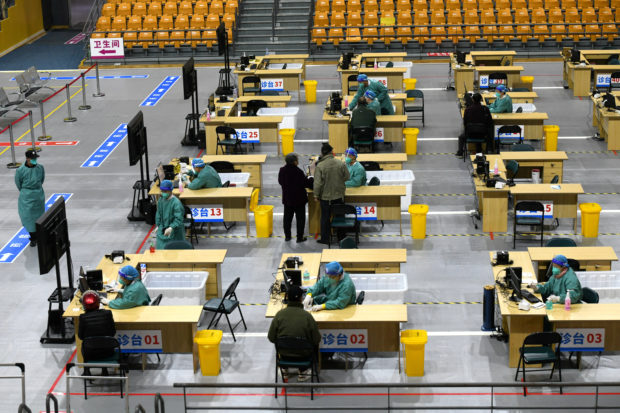China’s vast countryside in rush to bolster COVID-19 defenses

Medical workers attend to patients at a makeshift fever clinic inside a gymnasium, amid the coronavirus disease (COVID-19) outbreak in Fuzhou, Fujian province, China December 28, 2022. cnsphoto via REUTERS
SHANGHAI/BEIJING — China’s sprawling and thinly resourced countryside is racing to beef up medical facilities before hundreds of millions of factory workers return to their families for the Lunar New Year holiday next month from cities where COVID-19 is surging.
Having imposed the world’s strictest COVID regime of lockdowns and relentless testing for three years, China reversed course this month towards living with the virus, leaving its fragile health system overwhelmed.
The lifting of restrictions, following widespread protests against them, means COVID is spreading largely unchecked and likely infecting millions of people a day, according to some international health experts.
China officially reported one new COVID death for Wednesday, down from three on Tuesday, but foreign governments and many epidemiologists believe the numbers are much higher, and that more than 1 million people may die next year.
China has said it only counts deaths of COVID patients caused by pneumonia and respiratory failure as COVID-related.
In the southwestern city of Chengdu, funeral parlors were busy after dark on Wednesday, with a steady stream of cars entering one, which was heavily guarded by security personnel.
One van driver working for the parlor said the past few weeks have been particularly busy and that “huge numbers of people” were inside.
Hospitals and funeral homes in major cities have been under intense pressure, but the main concern over the health system’s ability to cope with surging infections is focused on the countryside.
At a Shanghai pharmacy, Wang Kaiyun, 53, a cleaner in the city who comes from the neighbouring Anhui province, said she was buying medicines for her family back home.
“My husband, my son, my grandson, my mother, they are all infected,” she said. “They can’t get any medicine, nothing for fever or cough.”
Each year, hundreds of millions of people, mostly working in factories near the southern and eastern coasts, return to the countryside for the Lunar New Year, due to start on Jan. 22.
The holiday travel rush is expected to last for 40 days, from Jan. 7 to Feb. 15, the Ministry of Transport said this week.
The state-run China Daily reported on Thursday that rural regions across China were beefing up their medical treatment capacities and ensuring availability of life support equipment and critical-care beds.
It said a hospital in a rural part of Inner Mongolia where more than 100,000 people live was seeking bidders for a 1.9 million yuan ($272,308) contract to upgrade its wards into intensive care units.
Liancheng County Central Hospital in the eastern Fujian province was seeking tenders for ambulances and medical devices, ranging from breathing machines to electrocardiogram monitors.
A hospital in Huailai county, in the Hebei province, also said it needed equipment for its emergency wards.
Testing requirements
The world’s second-largest economy is expected to suffer a slowdown in factory output and domestic consumption in the near term as workers and shoppers fall ill, but is seen as likely to bounce back later next year as COVID wave eases.
The re-opening also raises the prospect of Chinese tourists returning to shopping streets around the world, although some countries have been taken aback by the scale of the outbreak and are skeptical of Beijing’s COVID statistics.
China’s official death toll of 5,246 since the pandemic began compares with more than 1 million deaths in the United States.
The Chinese-ruled global financial hub of Hong Kong, a city of 7.4 million people which lost control of COVID earlier in the year, has reported more than 11,000 deaths.
The United States, India, Italy, Japan and Taiwan said they would require COVID tests for travelers from China. Britain was considering a similar move, the Telegraph reported.
The United States issued a travel alert on Wednesday advising Americans to “reconsider travel to China, Hong Kong, and Macau” and citing “reports that the healthcare system is overwhelmed” along with the risk of new variants.
The main airport in the Italian city of Milan started testing passengers arriving from Beijing and Shanghai on Dec. 26 and found that almost half of them were infected.
China has rejected criticism of its statistics as groundless and politically motivated attempts to smear its policies. It has also played down the risk of new variants, saying it expects mutations to be more virulent but less severe.
Omicron was still the dominant strain in China, Chinese health officials said this week.
Australia, Germany, Thailand and others said they would not impose additional restrictions on travel for now.
For its part, China, whose borders have been all but shut to foreigners since early 2020, will stop requiring inbound travelers to go into quarantine from Jan. 8.
($1 = 6.9774 yuan)
RELATED STORIES
Chinese make travel plans as COVID-19 rules ease further
‘It’s dead out here’: China’s slow exit from ‘zero-COVID’ policy
For more news about the novel coronavirus click here.
What you need to know about Coronavirus.
For more information on COVID-19, call the DOH Hotline: (02) 86517800 local 1149/1150.
The Inquirer Foundation supports our healthcare frontliners and is still accepting cash donations to be deposited at Banco de Oro (BDO) current account #007960018860 or donate through PayMaya using this link.